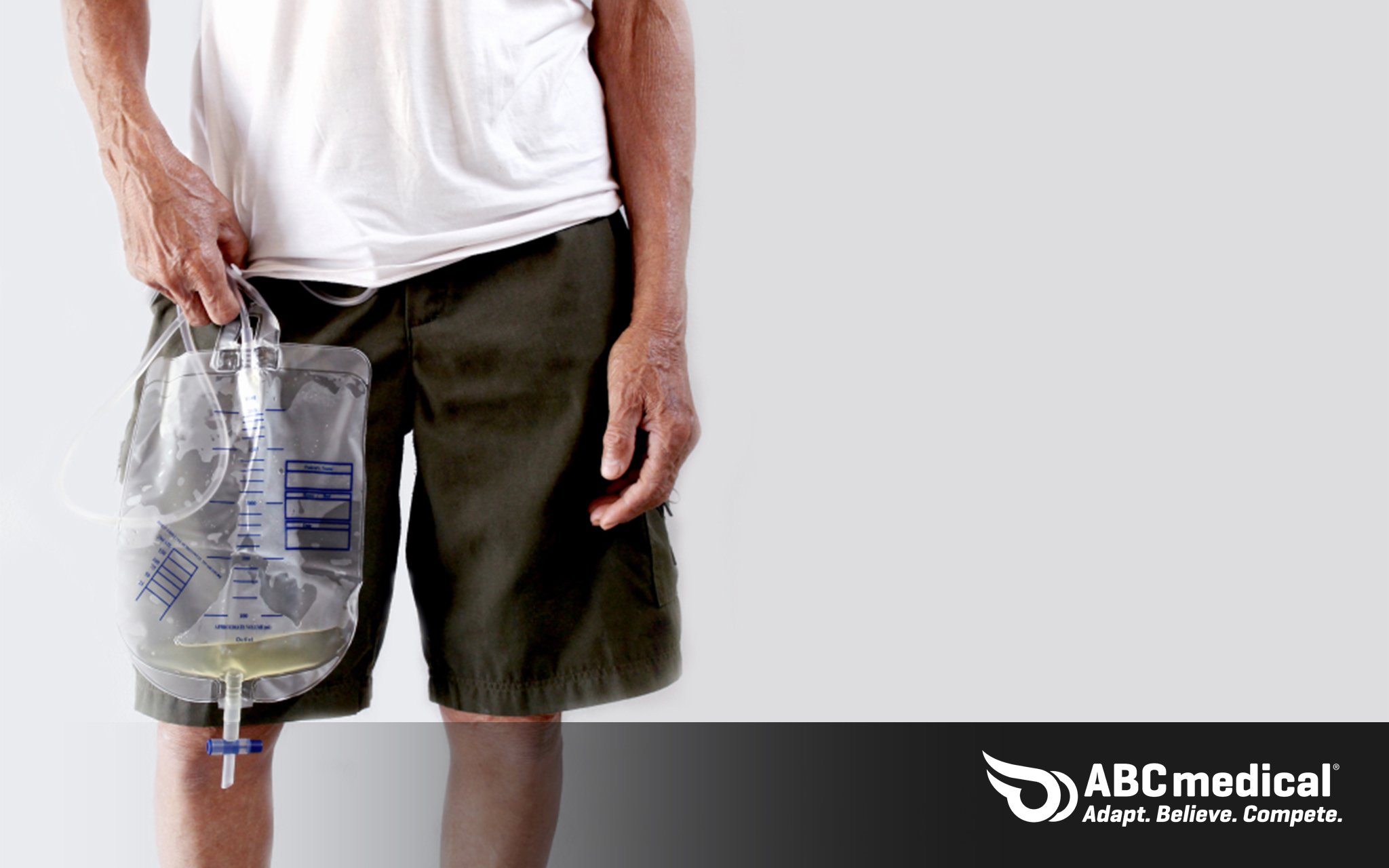
Urine drainage bags are, simply stated, storage bags that collect urine for individuals who cannot urinate on their own. They are typically used with catheter supplies such as Foley catheters, external catheters (condom catheters), urostomy pouches, or nephrostomy tubes. The urine drainage bag attaches to the urinary device with flexible tubing. Drainage bags are then emptied as needed into the toilet or another receptacle.
Urine drainage bags can be broken down into two categories: bedside drainage bags and leg bags. Bedside drainage bags are larger and designed to be hung off the end of a bed. They typically hold between 1000-3000ml of urine. Leg bags are smaller than bedside drainage bags and have straps that wrap around the calf or thigh. The leg bag can be worn under the clothing to discreetly collect urine. Leg bags typically hold between 500ml-1200mls of urine.
Urinary drainage bags should be cleaned each time after they are emptied. It is important to clean the bags properly to reduce the risk of infection. Cleaning urinary bags will also reduce odor and build up.
In today’s article, we will discuss proper cleansing techniques to keep your urine drainage bags fresh, clean, and functional.
Making a Cleaning Solution
You can make an effective cleaning solution for your urinary drainage bags at home with items available in your local grocery stores. There are two types of solutions commonly used by people at home: vinegar-based solution and bleach-based solution. A bleach-based solution is more effective for killing germs, while a vinegar solution is more effective for removing sediment from the bag. We will share recipes for each solution. Both solutions will effectively deodorize your bags. Diluting with water as instructed is important, as undiluted vinegar and bleach may damage the bag.
Vinegar Solution (1 part vinegar to 3 parts water)
Bleach Solution (1 part plain, unscented bleach to 9 parts water)
Getting the solution into the bags and tubing can be another challenge. Using a condiment-style squeeze bottle is a great option for storing the cleaning solution and getting it into the urinary drainage bag and tubing. This style of plastic bottle has a tapered tip that will fit into the urinary drainage bag tubing and spout, allowing you to thoroughly flush the tubing and bag with the cleaning solution. Here is an example found at Amazon: https://www.amazon.com/Katfort-Condiment-Dressing-Workshop-Dispenser/dp/B07W976P9G=
There are also premixed urinary bag cleaners available. Medicare and other insurances may not cover these premixed urinary bag cleaners, but you can purchase them over the counter. Here is a website where you can purchase urinary bag cleaner: http://www.catheterpros.com/p-19189-m9-odor-cleanerdecrystalizer-16-oz-480-ml.aspx?vid=18291
Cleaning the Drainage Bag
Before getting started, wash your hands. This is a good practice to avoid contaminating your urinary device. Sanitize your workspace and have all your supplies on hand. You will need a new or previously cleaned urinary bag, a bottle of cleaning solution, soap to wash your hands, a sink or shower with running water, and a place to hang your freshly cleaned urinary bag to dry. Before getting started, change out your dirty urinary bag for the new/clean one using the steps below:
- Wash your hands.
- If using a Foley catheter, clamp the catheter. If using a urostomy bag, close the spout.
- Detach your urinary device from the dirty urinary drainage bag.
- Attach your urinary device to a new or previously cleaned urinary drainage bag.
- If using a Foley, unclamp the catheter, if using a urostomy bag, open the spout.
- Note: Empty urostomy bags will sometimes create a vacuum when attaching to a new urinary drainage bag, causing urine to not flow into the drainage bag. The remedy is to leave some urine in the urostomy bag when attaching to the drainage bag so it will flow into the tubing when connecting, thus preventing a vacuum.
Now that you’ve attached to a fresh urinary bag, you are ready to clean the dirty bag. Follow the directions below to clean your bag and prepare it for future use:
- Empty all urine out of the dirty drainage bag.
- Flush the tubing and fill the bag with tap water.
- Shake or swirl the water around in the bag, then empty.
- Use a condiment bottle and flush the bag and tubing with cleaning solution, instilling approximately 1 cup of cleaning solution into the bag.
- Close the bag and shake the solution around for 30 seconds. (Some people prefer to fill the bag with the cleaning solution and let soak for a few minutes.)
- Empty the solution and rinse the bag and tubing with water.
- Hang up the bag to air dry.
Appropriate Number of Bags
Having adequate supplies is crucial for your routine. Many, but not all, insurance plans will cover 2 leg bags and 2 bedside drainage bags each month. Some people choose to use a bag for two weeks, cleaning and reusing it right away. Others will use both bags simultaneously, cleaning one and hanging it up to dry while using the other and switching them out each day. Regardless of how you choose to use them, having 2 bags on hand is a good plan. If one of your bags malfunctions or gets damaged, having an extra bag on hand will be helpful and get you through until you can get a new order.
For questions about what your insurance will cover, contact ABC Medical. Our team of insurance experts can help determine how many bags will be covered.
Disclaimer: This content is not intended to be a substitute for professional medical advice, diagnosis, or treatment. For medical advice, please speak with your healthcare provider.
References
- Ambulatory Care Ostomy Nursing Services, University of Michigan Medicine, 2020. Cleaning reusable urinary drainage systems. Accessed March 27, 2023. https://www.med.umich.edu/1libr/urology/CareReusableUrinaryDrainageSystems.pdf
- Madigan E, Neff DF. Care of patients with long-term indwelling urinary catheters. Online J Issues Nurs. 2003;8(3):7.
- Wilde MH, Fader M, Ostaszkiewicz J, Prieto J, Moore K. Urinary bag decontamination for long-term use: a systematic review. J Wound Ostomy Continence Nurs. 2013;40(3):299-308. doi:10.1097/WON.0b013e3182800305



